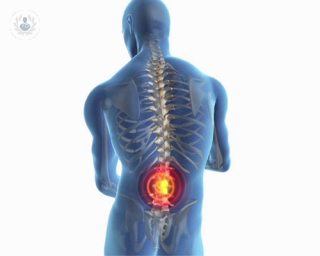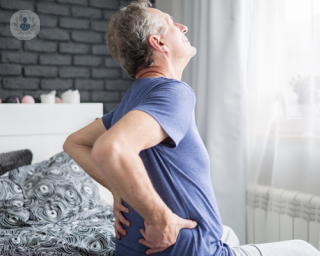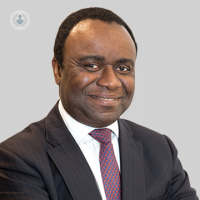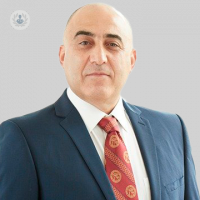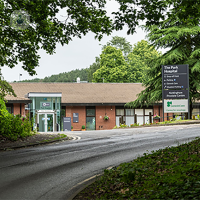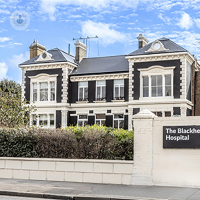Spinal stenosis
Dr Stephen Humble - Pain medicine
Created on: 11-13-2012
Updated on: 10-11-2023
Edited by: Aoife Maguire
What is spinal stenosis?
Spinal stenosis is a narrowing of the small spaces in between your spine which puts pressure on the nerves that travel through the spinal cord. It typically occurs due to ageing but older people are not the only ones who risk suffering from spinal stenosis. There are two different types of spinal stenosis, depending on the part of the spine where the condition occurs.
- Lumbar spinal stenosis: occurs in the lower part of the spine due to narrowed nerves.
- Cervical spinal stenosis: occurs in the upper part of the spine due to crowded nerves. Usually, those who suffer from spinal stenosis only suffer from one type but unfortunately, some people can suffer from both types of the condition.

Why does spinal stenosis occur?
Spinal stenosis usually occurs gradually due to aging, however, it can also be caused by deformities of the bones and tissues located around the spine. Normally, it affects people over 50 years old, but it can also be present in young people who have experienced some kind of spinal trauma in the past.
How serious is spinal stenosis?
Spinal stenosis can have a serious effect on the ability to walk due to pain and could eventually lead to the loss of leg strength, therefore it is essential to remain active in order to prevent this from happening.
What is the outlook for patients with spinal stenosis?
The severity of spinal stenosis can vary greatly depending on the intensity of pain. It usually correlates with the number of metres a person can walk without suffering pain. This means that if a person can walk below 200 meters before suffering pain, then it is considered serious, but if it’s below 50 metres, then it is considered very serious.
What are the symptoms of spinal stenosis?
In the early stages, spinal stenosis is usually asymptomatic, especially when there is no compression on the nerves. However, symptoms progressively worsen with time. These symptoms vary according to the location of the stenosis and which nerves are being affected. A patient may experience the following symptoms:
- Lower back pain
- Numbness
- Weakness
- Tingling sensation in limbs
- Burning sensation which flows from the buttocks to the legs
- Cramping in legs and feet.
Does spinal stenosis affect where symptoms are produced in the body?
Spinal stenosis in the neck produces symptoms in the arms, however, if it’s present in the lower back then symptoms may appear in the buttocks and legs. The most common feature in lumbar stenosis is the increased severity of symptoms when walking.
How is spinal stenosis diagnosed?
The first step to diagnose this condition is to perform a complete medical history review and perform a physical evaluation of the patient. In addition, physical and neurological examinations should be carried out. An X-ray, MRI and CT scan will allow a doctor to measure any damage to your disks and ligaments, reveal any bone changes and also detect any presence of tumours.
What are the causes of spinal stenosis?
The most common cause of spinal stenosis is due to degenerative processes as your body ages. Tissues in your body thicken, whilst bones also start getting bigger. Both of these can put pressure on the nerves in your spine. The following are other conditions that can cause spinal stenosis:
- Osteoarthritis and rheumatoid arthritis
- Defects at birth
- Medical history
- Herniated discs
- Paget’s disease
- Scoliosis
- Bone tumours
- Achondroplasia (growth disorder of the bones)
Can spinal stenosis be prevented?
The prevention of canal stenosis is fundamentally based on avoiding risk factors, such as:
- Obesity
- Repeated trauma
- Bad posture
Spinal stenosis due to ageing cannot be prevented but the risk can be reduced by exercising regularly, maintaining a healthy weight and practising good posture. It's important to practise good posture while you stand, sit, sleep or lift heavy objects. You can also do special exercises in order to improve your posture.
How is spinal stenosis treated?
Treatment of spinal stenosis varies depending on the affected region and severity. Usually, the first line of treatment is based on the use of medications, such as anti-inflammatories or corticosteroids to reduce pain and inflammation, combined with rest and physiotherapy sessions.
Due to the degenerative nature of the condition, spinal stenosis can worsen over time, therefore it is necessary to control it by slowing down the progression of the disease. As previously mentioned, exercise is essential to strengthen spinal muscles and will also reduce symptoms. As a result, this will help those who suffer from spinal stenosis to avoid more agressive forms of treatment.
Exercises which may help to strengthen the leg's muscles include:
- walking
- swimming
- water walking (in a swimming pool)
- stationary biking
In more severe cases, medications may be prescribed to reduce spinal pain. Surgical treatment is only recommended in cases where nerve compression is progressively aggravated. The operation seeks to relieve the pressure of the nerves in the lower part of the spine.

What can cause spinal stenosis to worsen?
While it is proven that exercise can be used to prevent worsening of spinal stenosis, there are certain exercises which can negatively impact spinal stenosis patients. Some of these exercises include:
- Running
- Extended walks
- Contact sports e.g. football and basketball
- Jumping
- Cycling
What specialist treats spinal stenosis?
Spinal stenosis is typically treated by a neurologist.

